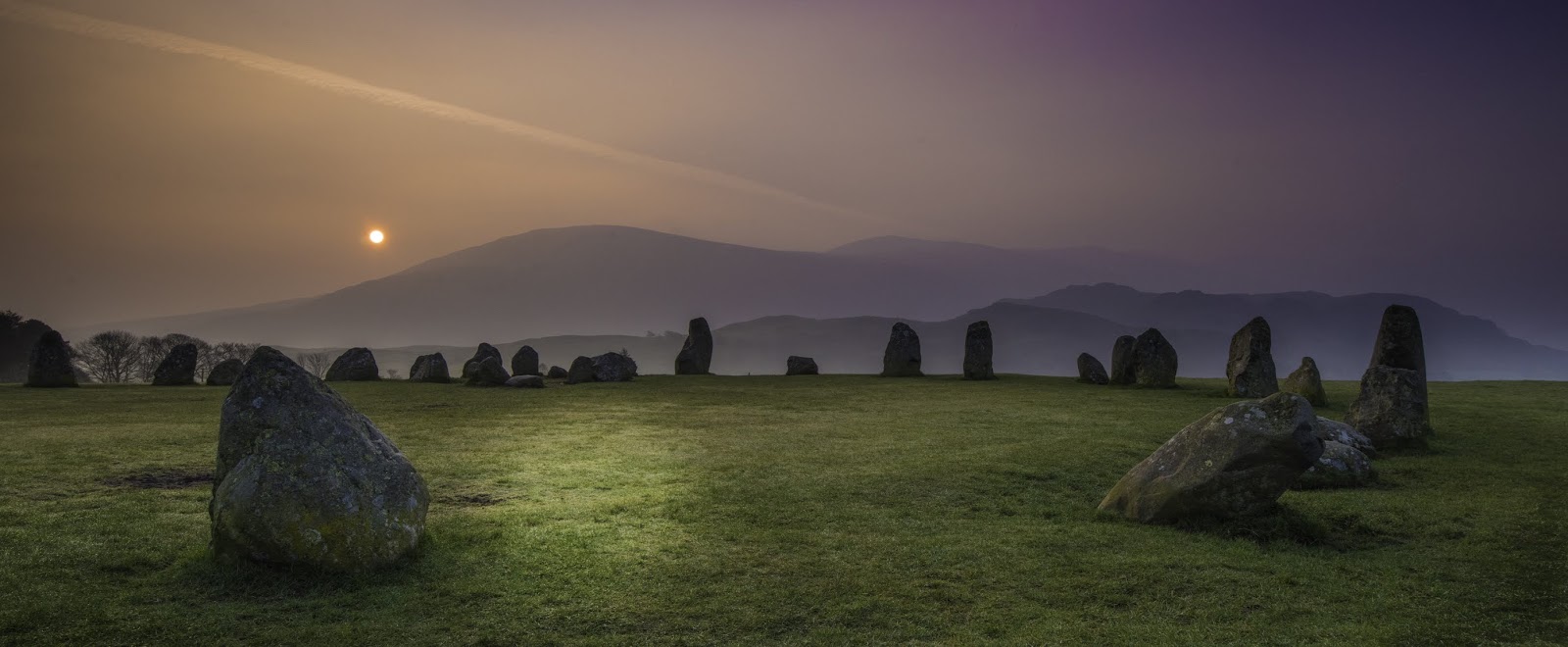Roman Amphitheatre of Uthina The Roman Amphitheatre of Uthina is located in Uthina , near Tunis, Tunisia . Building for Uthina began in 40 BC and continued through to 135 AD. The amphitheatre may have been a later addition to what was already a large town. Also located there were a fortress, cisterns, an aqueduct, a triumphal arch, a theatre, and a basilica with a circular crypt . Coordinates 36.608598,10.169214 Description The amphitheatre, partly buried, measures 113 by 90 meters. The arena measures 58 by 35 metres, giving surface areas of 7988 and 1539 square metres respectively. There are four entrances, two main entrances at each end, with the seating area supported by three tiers of columns and arches. (Although these are no longer there, measurements and amphitheater descriptions rely on a complete building.) Measurements for the amphitheatre on site are 12 0 by 89 metres, with the arena measuring 67 by 36 metres. The surface areas measure 10680 an d 24...
Castlerigg Stone Circle
Castlerigg stone circle near Keswick in Cumbria.
It is possibly connected with a Neolithic/early Bronze Age Langdale axe industry and a location for trade.
It is currently owned and managed by English Heritage, the circle is centred in the Lake district between passes and thought to align with solstices and sunrise.
The circle measures 32.6 m (107 ft) at its widest and 29.5 m (97 ft) at its narrowest, the official number or stones stand at 40, on their model stone circle there are 37 stones on the circumference and a further 10 inside.
The angles 48°/42° (used for primers) and 74° are used. Primers are derived from using the angles joining stones together. Usually, two stones on the same line equals 1 or 2, and only one equals 0 or 1. Here two are 1 and one is 0.
74° clockwise
48° anti-clockwise
Primers
1-1-1 0 1--11111
1---1-- X
Dashes as 0, 1 as 1 with groups.
=21×(100+5)
=1000/100/x
Using the numbers derived from above, these confirm the angles used and the following are produced.
74°÷3600=0.02055
2205÷10=220.5
2205×0.02055=45.31275
×3600=163125.9
÷1000=163.1259
This could be interpreted as 163° rotation and 1259 bc.
2205÷0.02055÷1000=107.299
220.5×0.02055÷360=29.805
These numbers are then equal to size in feet and metres, as have been measured by archaeologists.
Ring of Brodgar
The Ring of Brodgar is connected to this site by the interpretation of the equations. The angle 163° is used to rotate the stone circle, giving directions to other settlements like a map.
From Ring of Brodgar and using 163° rotation, the angles 9°/12°/20°/22°/35° are produced, two don't align with any known settlements, but three do.
During the Roman invasion of Britain, a Roman Legion was based in the area, most probably near Whitehaven. As some Neolithic sites were thought to have been altered by the Romans, this site seems to be untouched.
Castlerigg Stone Circle
Archeology77 ©
Castlerigg stone circle near Keswick in Cumbria.
It is possibly connected with a Neolithic/early Bronze Age Langdale axe industry and a location for trade.
It is currently owned and managed by English Heritage, the circle is centred in the Lake district between passes and thought to align with solstices and sunrise.
The circle measures 32.6 m (107 ft) at its widest and 29.5 m (97 ft) at its narrowest, the official number or stones stand at 40, on their model stone circle there are 37 stones on the circumference and a further 10 inside.
The angles 48°/42° (used for primers) and 74° are used. Primers are derived from using the angles joining stones together. Usually, two stones on the same line equals 1 or 2, and only one equals 0 or 1. Here two are 1 and one is 0.
74° clockwise
48° anti-clockwise
Primers
1-1-1 0 1--11111
1---1-- X
Dashes as 0, 1 as 1 with groups.
=21×(100+5)
=1000/100/x
Using the numbers derived from above, these confirm the angles used and the following are produced.
74°÷3600=0.02055
2205÷10=220.5
2205×0.02055=45.31275
×3600=163125.9
÷1000=163.1259
This could be interpreted as 163° rotation and 1259 bc.
2205÷0.02055÷1000=107.299
220.5×0.02055÷360=29.805
These numbers are then equal to size in feet and metres, as have been measured by archaeologists.
Ring of Brodgar
The Ring of Brodgar is connected to this site by the interpretation of the equations. The angle 163° is used to rotate the stone circle, giving directions to other settlements like a map.
From Ring of Brodgar and using 163° rotation, the angles 9°/12°/20°/22°/35° are produced, two don't align with any known settlements, but three do.
During the Roman invasion of Britain, a Roman Legion was based in the area, most probably near Whitehaven. As some Neolithic sites were thought to have been altered by the Romans, this site seems to be untouched.
Castlerigg Stone Circle
Archeology77 ©

Comments
Post a Comment